#and who is generally one of the load bearing pillars of the fandom and whose art i love!!!
Photo

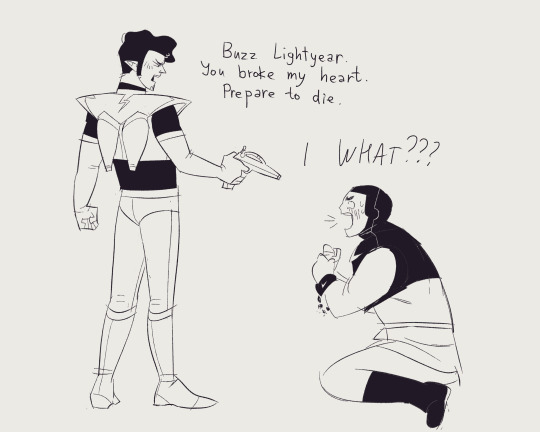

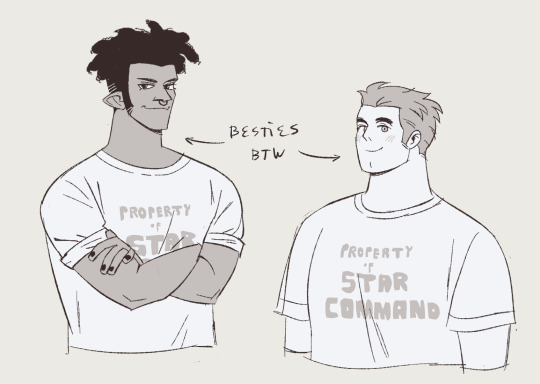
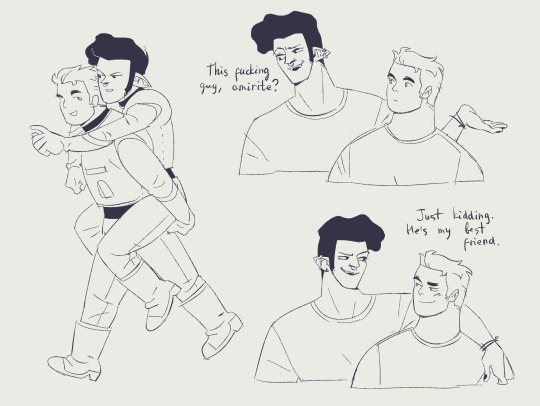
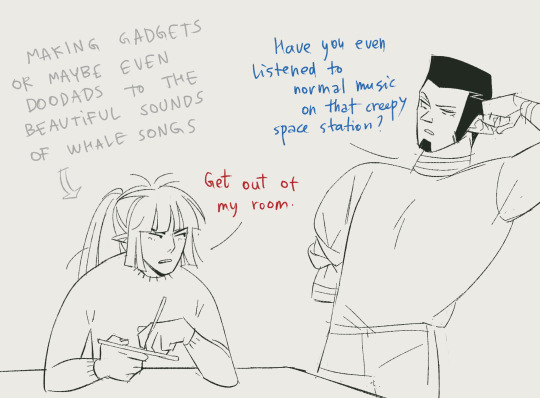
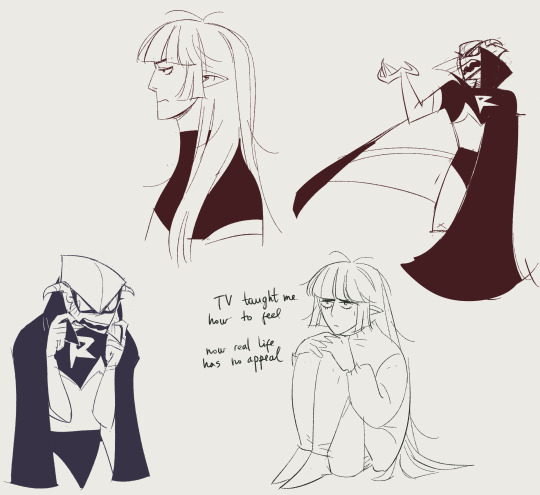
blosc doodle dump >:]
#buzz lightyear of star command#buzz lightyear#warp darkmatter#roza#xr#INCLUDING EVILYEAR.... full courtesy of safekeeperscosm whose evilmatter drawings give me life#and who is generally one of the load bearing pillars of the fandom and whose art i love!!!#origpost#drawpost#the 'just kidding' quote is also from the fic. you know which one#um and continuing with my warp being a marina fan agenda i think he would introduce roza to The Family Jewels#and she would lose her mind. she DOES know exactly what she wants and what she wants to be & why she walks and talks like a machine.#for context i think she grew up on an abandoned wall-e type self-sufficient space station#0 socialization besides talking to a computer or whatever robot personnel wasnt completely rusty with age#and 0 experience listening to teenage music. thats a major reason she thinks noone gets her lmao
66 notes
·
View notes
Text
Gundam IBO Odds-n-Ends (1/2)
Being the first part of an essay commemorating all the interesting, odd, and just plain funny screenshots I saved on my rewatch of Gundam IBO. I offer it in the spirit of shared fandom, as interesting information for the consideration of fellow fanfic writers, or simply meta for those who enjoy reading such things.
I have split these photos into three major categories: Worldbuilding, Characterization, and Hilarity. The first category is the largest, and makes up this first post. It consists of pictures that illustrate aspects of the show’s setting, and is further subdivided into Locations, Society, and Language & Arts. If any of those sound interesting to you, hit the jump!
Worldbuilding:
Locations: Screenshots of the various locales of the series, both to point out interesting things about them, and, about as often, to highlight hilarious signs. We begin, as the show does, on Mars.
I think it’s very easy to think of Chryse as kind of a dirthole in the show. We so often see it from the perspective of people like Tekkadan—whose base is located outside the city—or Atra, who grew up in a very poor area. Obviously there are some nice places, like Kudelia’s home, and there is a kind of dusty, sunny appeal to even some of the poorer areas, with their colorful signs and graffiti, but by and large, up until we start seeing locations like Admoss Company, it doesn’t seem much like a major planetary hub.
I think that’s because we don’t get a lot of high-angle views.

Here is Chryse as established in the very last episode, free from Earth meddling and finally self-governing. We’re clearly in its more affluent downtown area, given the government building (bearing the flag of The Martian Union) in the middle of the picture. It’s possible that it looks worse up close, of course, but notice the broad walkways, and the light-to-the-point-of-being-nonexistent traffic. Notice the splashes of blue, green and red in the architecture. Notice all the trees, both lining the streets and blanketing the city in broad swathes that would seem to indicate an unusually large concentration of lush parks. In the far, far distance, you can just see the mountains that surround the city on all but its north side.
All the evidence we have suggests a pretty awful class divide on Mars, but man, Chryse’s downtown area is still really nice. Kudelia probably spends large amounts of her professional time in areas like this.

Here, you can see that we’re far closer to the outskirts—note the slopes climbing rapidly into mountains—and are definitely back in a poorer area of town. The ground is bare, and there are no trees. At least the streetlights all work! Kassapa Factory is located in an area much closer to this than the gorgeous downtown, to judge from the proximity of the mountains in that final shot of Yamagi in the epilogue.
Moving on out of the city entirely—I’m thinking to the north, assuming the geography of Chryse is roughly analgous to that of Chryse Planitia, the Martian plain it takes its name from—one would find the Sakura Farm and associated holdings. We’ll stop in there later, but in the meantime, I did want to include this picture.

Though it’s never referred to by name in-series, this is the actual orphanage Kudelia founded at Sakura Farm. The photo is one of several in Kudelia’s Admoss office showing her company holdings—there’s also a picture of the mines—and was presumably taken not long after the building was built, judging by the lack of the art that would eventually come to decorate all its exterior walls. Derma and Dante work here in the epilogue, but Atra lives on the farm as well, so one can assume Akatsuki is never lacking for other kids to play with.
We move now to Jupiter—or at least, one of the colonies orbiting Jupiter. Saisei, where McMurdo Barriston lives and reigns, is home to an extremely healthy little shopping district, and it is just full to the brim with interesting or hilarious storefronts. Lets look at some of them!
First off, Saisei is loaded with bars. Seriously, the one the boys stop in on their first visit, Pub Someday, is one in a string of at least three—it’s sandwiched between Public House (‘public house’ being the term that the word ‘pub’ actually derives from) and Pub Always. I think Naze probably recommended Pub Someday to them, and I think that largely because, left to their own devices, I’m sure they would have gone into Pub Always instead. Why?
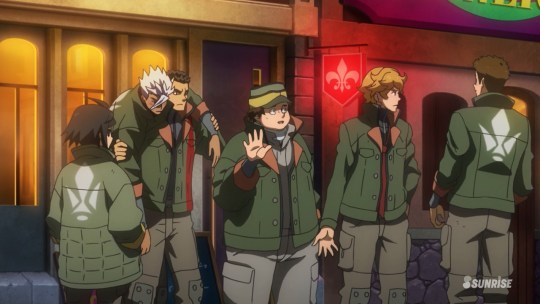
Note the neon red and white fleur-de-lis hanging on the side of the establishment (which they’re standing around in front of the entrance to because they’re a bunch of ill-mannered yokels). My god, how did they not go into this place? It has their logo just right there on it.
There are marginally less alcoholic portions of Saisei, however, like the one Lafter and Azee go do a touch of retail therapy in after Naze’s memorial service. They pass a store just called Delicious, but I think my favorite was HOUSE STORE, seen below.
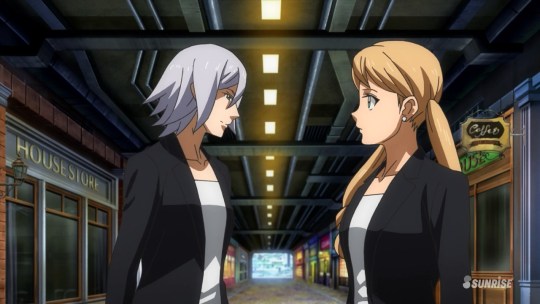
What does one buy at this store, I wonder? Furniture? Furnishings? Knick-knacks? Oh, perhaps it’s actually an office front, and this is where one comes to rent/purchase an apartment or other living quarters at Saisei?
Down the way from HOUSE STORE, of course, is the ill-fated Bear Factory. I want to look at the place next to it, though, because it has caused me some serious confusion.

So, the imagery here—the slightly frosted glass, the gold lettering, the delicate wrought-metal window decorations—suggests something like a high-end coffee shop, or perhaps some manner of light, ritzy soup-and-salad-type lunch café. If you run a Google search for “cocotaso,” however, the primary thing you’re going to get is something that does not at all match this building’s elegant exterior.
At least so far as the English-speaking world is concerned, “cocotaso” is a Hispanic-by-way-of-the-Caribbean slang term for when someone (often a parent) strikes you on the head with their knuckles; it’s usually in the context of a disciplinary hit, like a kid in the US might describe getting a ruler rapped on their knuckles, or “dekopin,” the forehead flicks you see in anime sometimes (in IBO itself, even—Naze drops one on Orga early on).
Now, I did manage to dig up another possibility, one that’s definitely the more likely reference, if by far the less popular Google result. “Coco” by itself is the Spanish word for “coconut,” and it’s possible to find some bottles labeled “cocotaso”/”cocotazo” advertising coconut water or coconut-infused brandy and the like—mostly by running the term through Image Search instead of a straight Web Search. I have no idea what the taso/tazo is indicating there, unless it’s just colloquial—particularly in the case of the booze, it’s no different than calling a drink a Screwdriver.
So, if I had to guess, I’d assume this lovely storefront is yet another bar, one of a vastly different cultural influence than we see in literally any other place in the show. I find it alternately hilarious and rather confounding.
Anyway, Saisei is really great to me, you guys. It’s like the space Mall of America except there are 1000% more bars and it’s run by the mob.
How about anything else around Jupiter, though? Saisei is literally all we ever see of the Jupiter Sphere, which is a bit disappointing when you’re wanting more worldbuilding. Well, I did spot one image that might be giving us a look at something else in that area. Specifically, in Naze and Amida’s flashback, we see them in a nice hotel room following a successful delivery, with Naze asking her to stay on with him more long-term. There’s a brief moment where the camera looks out the window, and gives us this vista:
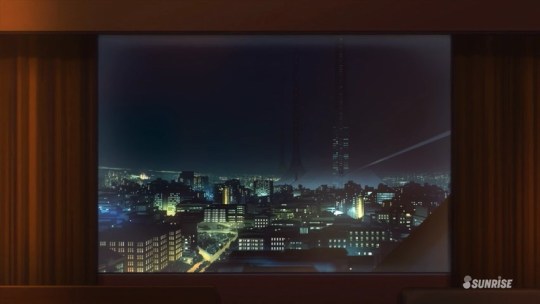
You can compare this to the scenes that take place outdoors on the Dort Colonies; the structures running down the center right of the picture are clearly of the same general design. A close analysis, though, suggests that it’s definitely not one of the Dorts we’re looking at here. For starters, they’re huge. Compare the 4-to-5-storey buildings on Dort to the huge office buildings here; they come up to about the same height relative to their respective pillars. There are also the lights up the center of the structures, suggesting some absurdly expensive offices or apartments available to rent—the pillars in Dort don’t have anything like that. Consider too the fact that in outdoors shots in the Dort Colonies, you could always see either the central pillar or the curve overhead of another part of the colony, often both. While it’s nighttime here, the way the whole town is lit up suggests that, if this colony were the same size as Dort, its sky should be full of “stars”—the lights from the buildings on the other side of the ring. But the sky is black and empty, without even a suggestion of the central pillar, much less the other side of the colony.
No, I’m inclined to think that this our only look at an actual colony in orbit around Jupiter—not an enormous ship like Saisei, which is technically classified as a “large planetary cruiser,” but an actual permanent colony. It’s one of the most metropolitan-looking places we ever see in the show, and certainly offers a fascinating glimpse of a place in the Jupiter Sphere unattached to Saisei.
One last look at a planetary location, in one of my favorite bits of accurate but poorly deployed English in the show. This shot is from Edmonton, during the Season One finale.
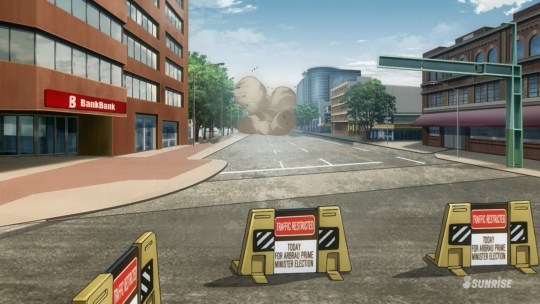
I direct your attention, not to the perfectly acceptable roadblock signs, but rather, the large bank on the left side of the road. You can tell it’s a bank because it’s been helpfully labeled as such. Twice, even, in case you missed it the first time. I mean, I guess you could say that this reflects the fact that Earth is divided up primarily by business interests. After all, normal banks are named after people, or regions, or types of trees, or major industries in the area—something sort of pleasantly descriptive of their history or business aims. But as Earth is run by divisions literally called ‘economic blocs’, you certainly can’t get much more descriptive than BankBank.
Meanwhile, out in the vast reaches of space…
Possibly this was obvious to everyone but me, but in the interest of sharing the information with people who share my lack of experience with a) sci-fi and b) mechanical thinking, I offer a pair of pictures of the bridge of Rustal’s ship, Arianrhod’s flagship vessel.

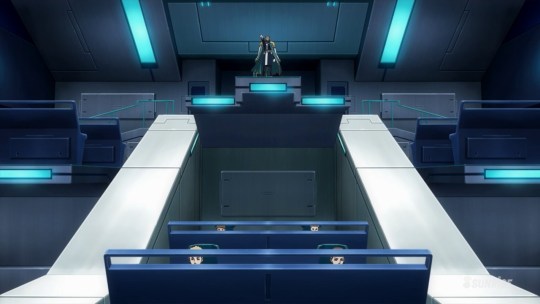
Like, compare those working areas, that raised, rear bridge area to the same layout on the Isaribi. I’m pretty sure just half of that back area would fit Tekkadan’s whole bridge. Tekkadan’s bridge has five positions counting the captain’s seat—the halfbeak here seats—what, like thirteen? Cripes.
Speaking of things that are way bigger than I had initially assumed, my last photo for this section is of one of the Ariadne beacons.

That tiny little lifted bit crowning the Isaribi is, of course, its bridge, where Orga and company hang out all day on their space travels. Compare it to the beacon in the background. I had no idea the Ariadne beacons were so huge until I went looking for a picture of one. I’m pretty sure just the lighting array on that thing is taller than a grown man, and that’s with the beacon still fairly well in the background of the shot. I have no idea why anyone might need this knowledge to write fic with, but I did think it was interesting, so there you have it.
Society: Pictures of stuff in the world, things that illustrate local color, shadows of unnamed organizations, bits of home furnishings, and other such things that influence what you might loosely call the setting’s ‘lifestyle’. As before, lets start on Mars.
One of the things we see, if I recall, fairly early on with Atra is that she knows how to drive. This crops up periodically throughout the series, with probably its best showing in the season one finale, but my favorite scene of Atra driving is probably in the first episode of season two. Why? Well, because in season two she has her own car—and you can tell its hers by the vanity plate.
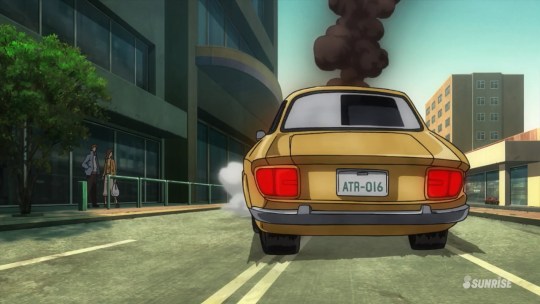
“ATR” for Atra, “16” for the year (most of) the show aired in, see? I’d also peg the 016 as indicating Atra’s age at the time she did the paperwork for the vehicle registration. Kudelia is sixteen when we first meet her (per Gjallarhorn’s info), and Atra being two years younger than her feels about right. This would also make Atra sixteen or seventeen when she and Mikazuki make a baby together, which is in line with Japan’s prefectural laws regarding the age of consent.
The vanity plate lettering aside, this does also tell us that cars need to be registered with someone in this world, which further implies the existence of a Martian DMV, which is just delightfully terrible.
It’s probably so terrible that when people get done, they really feel they need a drink. Well, luckily the setting has loads to offer on that front. Consider the following:
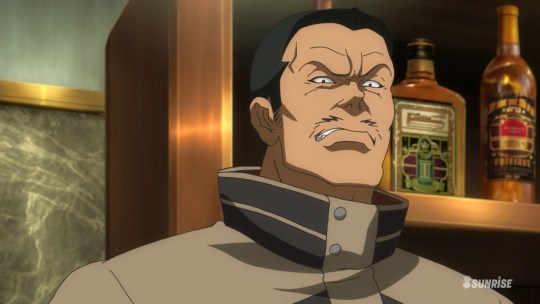
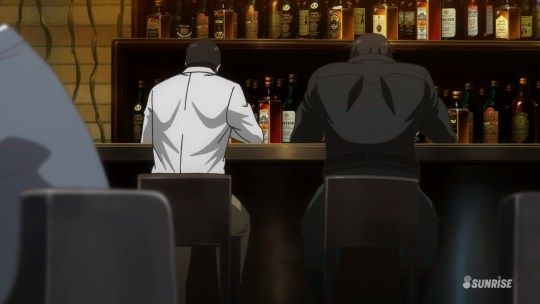
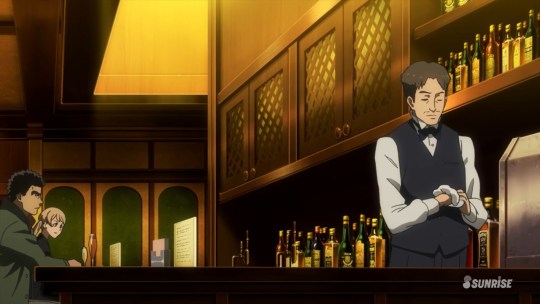
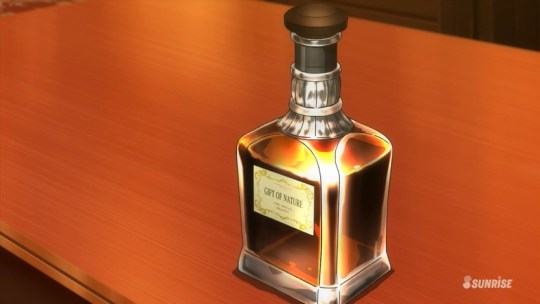
(What do you suppose happened to all the booze in Maruba’s office? I’m inclined to think Orga didn’t have time to do much with it just after the coup, and by the time he got back, he’d had the experience of getting trashed at Pub Someday and decided to cultivate less vomit-inducing vices.)
So, one thing to note is that, at the official bars in the setting, you tend to see a pretty high amount of repeat bottles, especially at that Earth-side bar Galan and Radice are meeting at. I’m altogether certain that the meta reason for this is just duplicated resources—setting designers have only got so much time to slap together alcohol label designs—but it is a little interesting to contemplate in-universe reasons. If so much of Earth was destroyed, how much is really suitable for cultivating the sorts of plants you need for alcohol? Is vineyard destruction why so few of these bottles look like wine instead of amber liquors like bourbon, brandy, and rum?
Moreover, is Pub Someday considered to be a “fancy” place (per Lafter) because it has Earth booze? Note that you can see some label overlap between the first and third pictures if you look closely, whereas the stuff in Maruba’s office doesn’t match anything else. Do they manufacture alcohol on Mars? Are there any local specialties? Is import and export very restricted?
The “Gift of Nature” there is, if I’m reading the label right, a brandy—though a cheap one, according to Amida. It’s Naze’s favorite, the one he and Amida drank at their first meeting (though the label on that bottle looked different—perhaps a redesign has happened in the, what, 10+ years it’s probably been since then?). From an American perspective, this is pretty amusing to me—brandy is one of those drinks with a very posh, moneyed kind of image about it. That Naze buys Amida cheap brandy—a poor man’s rich man’s drink—really just says everything about where he was in his life at the time.
But talking of money: I mentioned this some time ago in one my Human Debris Masterpost installments, and at least one fic I wrote for Yuletide last year, but: we do actually have a canonical shot of what denomination this setting’s money comes in.

Two possibilities here. The obvious one, phonetically, is that the money in this setting is literally named after its biggest police force, Gjallarhorn. This is both funny and deeply depressing, but either way, illustrates Gjallarhorn’s power in the setting. It even makes a certain amount of sense, if Gjallarhorn is nominally there to arbitrate between the economic blocs—you would want a common currency, and wouldn’t want it to be too tied to any one bloc.
There’s also a Norse myth that’s relevant, though, and given how accurately the Vidar reference was deployed, it’s worth looking at what ‘galar’ could indicate in that context.
Fjalar and Galar were dwarf brothers, distinctly murderous ones, and their main claim to fame is the murder of a supernaturally wise man, Kvasir, and use of his blood to create the mead of poetry, which grants wisdom, knowledge and creative inspiration. Using Galar as a name for money is an ugly little metaphor, I think, and one I could certainly see some very smug—or deeply jaded—scholar coming up with. Money buys all manner of things, of course; artists can have patrons, put money in, get art out. But because the denomination isn’t named for the source of the inspiration, the murdered man, but rather one of his murderers, there’s an undercurrent of violence, a suggestion of blood money. No matter what you want, throw enough money (violence) at it, and results will blossom beautifully. Guys, I’m pretty sure whoever named this setting’s money lost his entire family in the Calamity War, or something equally morbid.
As to its value, I think one galar is probably far closer to one yen than one dollar. Why? Well, while I can’t remember where I pulled this shot from (Atra’s flashback to meeting Mikazuki, maybe?) we do see bills in this exact same denomination in one other place in the series—the cairn for Tekkadan’s dead after the fight with the Brewers. So, yes, I think the bits of money that a bunch of underpaid orphans were able to scrounge up out of their pockets to literally shoot into space are likely to be very low value indeed. I imagine most major transactions are just handled electronically.
One other thing: I think this is the back of the bill. If you compare it to the reverse-side of the same denomination, the other side has the more elaborate design, the more visible numeral, and higher general visual clarity. It also has a big old picture of the African continent on it—perhaps other denominations also feature geographic regions? On the reverse side, meanwhile, are an indiscriminate blur of what I think are meant to be people, presumably some manner of historic group or another.
While we’re talking about emblems and the setting’s peace-keepers, I want to point out something I noticed in the epilogue—I think Rustal’s done away with the Seven Stars logo? Like, it’s still on all the flags at Vingolf, but there’s a new one on the Reginlaze standing behind him when we first see him in the epilogue and find out he’s become the new head of Gjallarhorn.

On the old emblem, six stars surround the central star; on this new one, the top and bottom stars have been removed. I wouldn’t think it was to honor the fallen members—the Seven Stars as a governing body were retired, first of all, so they shouldn’t be on the logo at all anymore. More to the point, though, the group lost three families, not two—Issue, Kujan, and Fareed. Perhaps the new arrangement is a reference to the four economic blocs, with the cental star now representing Gjallarhorn itself?
Still talking about emblems, here’s a screenshot from way early in the show:

So, as far as I can tell, this is the emblem of Gjallarhorn’s medical branch—you can see the same uniform on the doctor getting yelled at by Gaelio about Ein’s prognosis, later on. And that’s all well enough as it is—I wonder what the logo is meant to represent, in an organization so built around Norse mythos?—but we do see it in one other, somewhat more interesting place as well.

First-aid kits! So I guess we can assume the logo fills in the place of our world’s red cross. Of course, in our world the red cross is a legally-recognized emblem that can be misused or misapplied, in use the world over (with different variations in use in other countries, most prominently the red crescent), not bound to any particular government. Unsurprisingly for the Iron-Blooded Orphans world, their red cross is affiliated primarily with Gjallarhorn—no different than their money, I suppose. I wonder, very much, if the economic blocs have tried to keep their own currencies and the like that struggle to remain valid under the supremacy of Gjallarhorn?
But, enough about institutions! Who wants to look at home furnishings??
Specifically, the furnishings in what I’m assuming is the Fareed apartment on Vingolf, as we see McGillis and Almiria here repeatedly in season two, and it’s the place where Almiria stands her ground as McGillis’s wife against Gallus coming to take her back home. It’s an interesting mix of fairly standard looking furnishings—nothing too futuristic or archaic, just a modern-looking space, airy and warm, if perhaps with one too many chairs in it. There are only two things in it that stand out to me on a technological level.
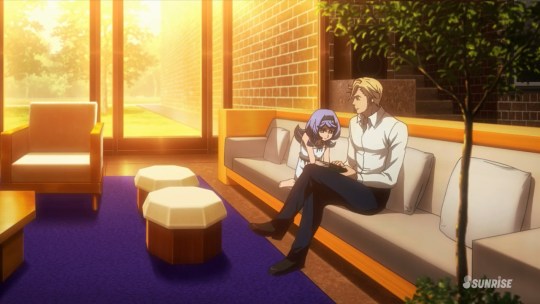
While I’m pretty curious about where those stairs hiding behind the potted tree go, given the stretch of building visible outside the sliding doors, what really caught my eye here was the speaker system tucked against the bricks, above McGillis’s head. It looks like such a perfectly real-world device, so much so that I wonder if it’s some kind of antique, or built to resemble one. I’m pretty certain we never see anything else like it in the show, and it makes me wonder about the role music has in this setting, especially recorded music.
Is it a thing for the very rich only? Are there Martian radio stations? Are there subtle variations between the genres of music popular around Jupiter’s moons? What about live music? Does anyone busk on the streets with hand-me-down musical instruments? How much would the Seven Stars pay for live entertainment at one of their important parties? Are there still famous musicians that hold blow-out concerts on Earth? How much cultural exchange is there between the planets and colonies in the system where their music is concerned?
Moreover, what kind of do you suppose McGillis likes? Myself, I’d guess big Wagnerian operas with convoluted plots and a lot of tragic-yet-noble bloodshed. I feel like it’d appeal to the same moral binary in him that the Gundams do.
The other thing in this space that caught my eye is the fireplace. What’s that? You don’t remember there being a fireplace? Well, that’s because…
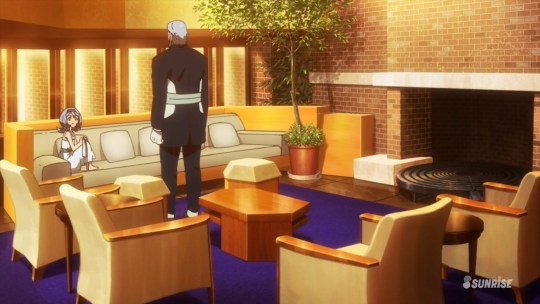
This—this can’t be very safe, can it? I mean, it’s basically one enormous heating coil, like someone super-sized an electric stove and plopped one of the heating elements down in their living room. But, again, it’s huge. I have no doubt it can heat that whole room; what I question is the idea that any of that furniture wouldn’t be much too close for comfort. To say nothing of the carpet!
Also, if you’re not going to have actual open, dancing flames (or at least an image thereof), why bother with the huge recessed space for it? And does that space lead to a chimney? Is this just the world’s most bizarre space heater design? I am just—so totally baffled by this thing.
Lets look at someone else’s living space.
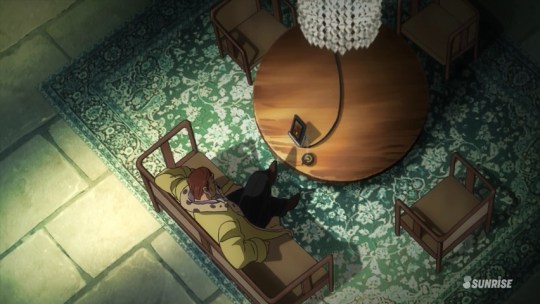
I saved this first with the thought, “Man alive those are some huge bricks; where did he even get them?” I have since realized that, duh, they’re certainly stone tiles, not huge bricks, but still, they are pretty ginormous, and lend a chilly, austere severity to Jasley’s room. Most of the wealthy seem to prefer warmer spaces; McMurdo Barriston and Nobliss Gordon’s offices are all wood and warm brown shades (even though Gordon likes to sit around in the dark), maybe accented with cool furnishings here and there. Likewise McGillis’s apartment, above; the enormous purple rug in the middle of it is the one cool touch in a mostly neutral-warm palate.
This certainly contrasts Jasley, who is, I’m pretty sure, one of the financial moguls of Jupiter—he heads J.P. Trust, which sounds very much like a bank name to me, and we know finance is one of Teiwaz’s corporate activities. Does he just has unusually spare tastes for a rich man in the setting? That seems unlikely, given his loud coat and paisley-decorated battleship. Or is the loud stuff for a public face, while privately he prefers the more stark sensibility? (Of course, it’s also possible that it’s mostly a meta choice, to remove any warmth from around the character, as he’s not a man the audience is meant to feel warmly towards. But I always want to look for the in-universe reason first, for a project like this.)
Also, Jasley, you’re so rich. Get some more comfortable furniture for you and your goons to sit on, jeez.
Lastly, to stay with Jupiter for a moment longer, I offer some flowers.
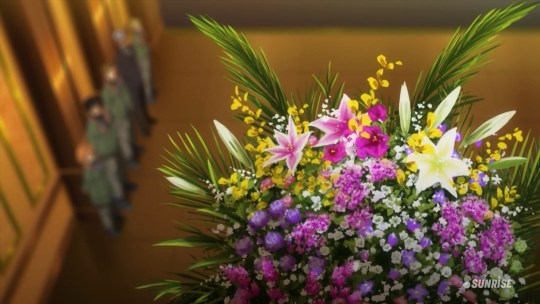
This is the arrangement Jasley sent to Naze’s memorial service. I wondered for a bit where these come from—imported, for maximum braying display of wealth and power? Local, because trying to transport fresh flowers across the expanse of space sounds like an enormous pain in the ass when you could just build a greenhouse locally? It seems to me that these are probably local—local to Saisei, even. All the other flower arrangements in this scene look like they contain mostly the same sorts of flowers, just in far more modest numbers. That suggests to me that there’s probably a florist in Saisei’s shopping district who occasionally gets ludicrous amounts of money from some mafioso or another who wants to swagger a bit at a rival’s memorial. What a life, eh?
Lets look at a little more ‘in-the-life’ stuff for the setting.
Language & Arts: A short section on, as it says, language and arts.
So, while of course the series is voiced all in Japanese, overwhelmingly, the written language of the setting is English. The signs, text from Gjallarhorn/Ariadne databases, newsfeed scrolls—all of it is in English. Given the cultural mishmash the Earth and its outer orbit colonies have become—look no further than Mikazuki Augus sitting alongside Biscuit Griffon!—I’m inclined to think English is just the language that survived as the dominant written text, and is probably the language everyone is “actually” speaking (see Translation Convention). There are a few places where others crop up, though! They are in exactly the places you’d expect.
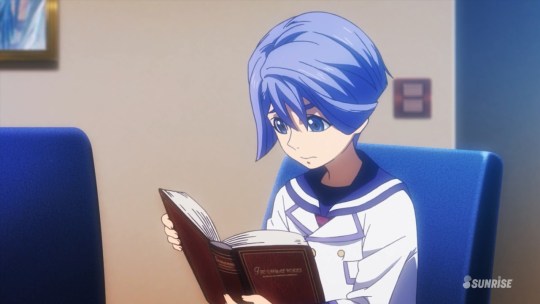
I can’t make out the full title on the book kidlet!Gaelio has here, but I do see “Im” and “Wald,” so it’s “In the ____ Forest” in German. I can’t imagine the organizations’ members on the whole speak the language—we see English on all their screens—but it’s not at all surprising that the leaders of the organization would have some exposure to it, though German is not, itself, a linguistic descendant of Old Norse. (Of course, if associating Norse myth with the German language is as close as IBO ever gets to the UC’s fascination with Nazi stand-ins, we should all count our blessings.)
The other language in the show is the more obvious one—Teiwaz is the place in the show where the yakuza/mafia trappings dwell most openly. The first time we see Japanese in the show is in their brotherhood ceremony, and they are where it crops up most regularly. There are a few places I’d like to mention specifically, though.
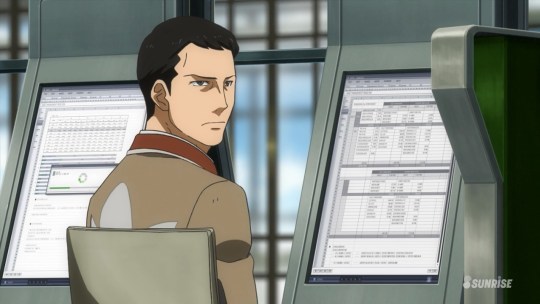
So, that thing I mentioned earlier, where I said the language on screens was always English? This is the only exception, and it’s really cleverly deployed. Teiwaz may or may not conduct all their internal business in Japanese—their ceremonies use it, but English is still the dominant written language in Saisei—but Radice uses the language for all his accounting. We know that, not only did Radice betray Tekkadan to Galan Mossa, he had also been engaged in the more mundane crime of embezzlement, and who would ever have caught him at it? No one in Tekkadan reads the language, even if they did understand accounting well enough to follow his tracks—Merribit was, I suspect, the only person in the organization who had even a chance of figuring it out, and she was on Mars. Radice is a rat bastard, but not an un-clever one.
The other places we see the language in the show are unconnected to Teiwaz, save perhaps through discreet family alliances. We see Iok practicing some calligraphy during his mid-season “exile,” and we know he has a longstanding family connection with Teiwaz, so him playing around with the language is eyebrow-raising, but not all that shocking.
The other place is a little weirder, though.

Okay, so, Makanai Togonosuke—that is a seriously Japanese name. I think he’s actually the only example in the show of someone who has a Japanese family and personal name. He was the Prime Minister of the economic bloc that had its capital in Edmonton, Canada, but that’s not so strange—the economic blocs encompass huge, improbably strata of geography, after all. The weird thing is that Arbrau isn’t the economic bloc that actually includes Japan—Japan is in the Oceanian Federation. Arbrau has all of Russia, which certainly gets it very close to Japan, but it does make me very curious about Makanai’s early history.
Did his parents emigrate? They must have stayed fairly connected to their Japanese heritage—despite being a leader of Arbrau, Makanai never lost his grip on Japanese culture. It’s not just his name, but his clothes and his housing, too. Of course, his island exile might have been around Japan; if he maintained strong ties to the country, and remained fond of it, why not live there while in exile? This would certainly match with having to travel over water to land in Anchorage. Perhaps this strong connection factors into whatever scandal it was that got him ousted in the first place?
In any case, it seems Japanese culture certainly survived the Calamity War and on into the future, where we can still find calligraphy practiced as an art, and bonsai trees tended as a hobby.
What about more traditional art? Well, certainly you can find examples of paintings all over the show, in offices and halls and homes. I wanted to turn my eyes to two specific examples of things we see framed in the show. The first is not a painting, but actually a photograph.
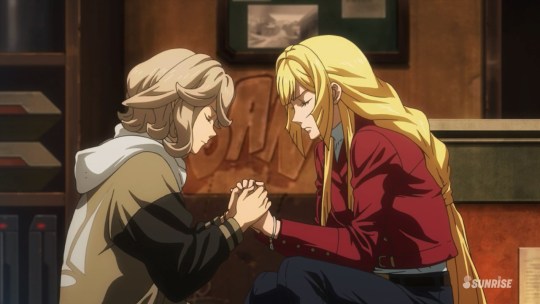
Specifically, it’s a black and white photo (maybe two of them) hanging up in the store where Atra worked at the beginning of the season. Now, a black and white photo hanging in a store wouldn’t seem so strange in a modern setting—it’s the town founding! Or the store opening! Or just some generic decoration!—but it does seem pretty weird in a futuristic setting long, long after the development of color photography! We know color photography still exists—the show’s last ending sequence is a slow pan-out from an in-universe photo, after all—so what possible reason could there be for the set of black and white photos here? People work in monochrome for artistic reasons sometimes, but this photo is just a bunch of buildings—it really does look like a “founding of the town” kind of photo, save that, again, this is a far-future sci-fi setting that has no reason to have been limited to black and white photography any time within the last, what, four to five hundred years?
Suffice to say, I find it pretty bizarre.
On the topic of pictures of places from long ago, though, what does everyone make of the painting on the left here?

Specifically, what are those spires on the left side? They don’t look like any kind of object I can make out, nor any sort of architecture with which I’m familiar. They’re not ship masts, nor do they match up with Gjallarhorn’s HQ ship-island, Vingolf. I sort of like the idea that we’re looking at some kind of very early spaceport facility, though the geography on the right side is a little prominent to be landing a big shuttle on. It almost has to be some kind of old Earth structure, though, given the painting’s location in the private home of a member of the Seven Stars.
Lastly, I wanted to showcase something that I wish I saw paid a bit more attention to in all the post-series Ride drama—the young man’s artistic streak. I can’t prove he’s responsible for every one of the works below, but it does seem in line with what we know he did—the Tekkadan logo, which Orga asked him for, and no small portion of the Isaribi’s interior graffiti, which we can see him working on in the second closer. He has an eye for fun shapes and mural work, and if he’s responsible for all or even most of the paintings we see around Tekkadan and Tekkadan-adjacent properties, art clearly consumed a huge portion of his time. Of course, for all the hugely colorful work on e.g. the orphanage, we don’t see Ride doing anything artistic in the second season. In retrospect, I wonder if this is some early foreshadowing of the darker path he’s headed down—that he puts down the paintbrush to focus on mobile suit training instead.
In any case, here are a few screenshots of, presumably, his stuff that caught my eye.
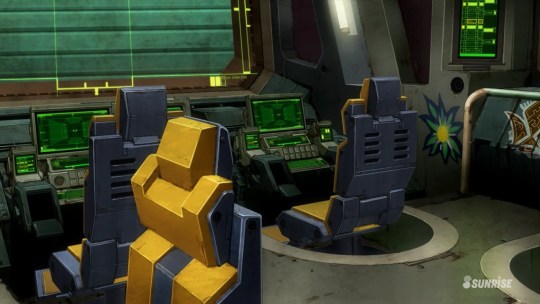
It’s a little thing, but the sunburst here is pretty, its curves and use of color somewhat more delicate than a lot of Ride’s stuff. A lot of his stuff is big and bold, using large amounts of red, orange and gold—this is softer than that, though it still speaks to a certain brightness of image and hope. It even kind of matches the bridge’s color palate!
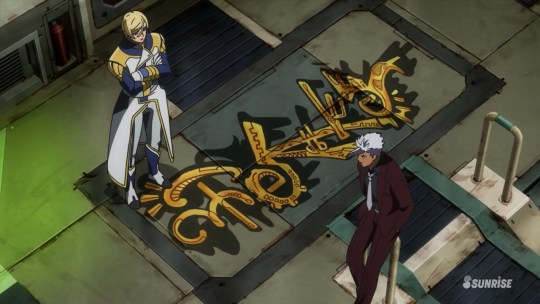
This, on the other hand, is much more in keeping with his usual stuff. It also confounds me, in that it certainly looks like calligraphy, but I can’t make heads or tails of any Japanese characters that might be hiding in there, and it certainly isn’t using the English alphabet. I’d dearly love to know what, if anything, it’s saying, though. If it isn’t a rendition of any particular writing system, I wonder if it was inspired by Teiwaz’s big brotherhood ceremony banners? Ride wasn’t at that particular ceremony, but enough people were whom Ride might have pestered for details about what it was like that I could see him hearing about it—and that’s assuming he didn’t just see some around Saisei or the Turbines ship at some point between Tekkadan’s first joining up with Teiwaz and McGillis and Orga standing around having this conversation. If that is the source of the inspiration, I wonder what Ride was trying to communicate with this? What words he thought he was writing?

Lastly, I turn an eye to this fountain of feathers. This is the least likely to be Ride’s work of the three, especially if it’s chalk instead of paint, but if it is his, I wonder where his mind was at when he drew it? Wings, for freedom? Feathers, for angels, for death and/or the afterlife? It’s a piece that looks perpetually unfinished, or perhaps restless—I like to imagine it is his work, but it’s from after Orga and Mikazuki’s deaths, but before Ride has cut ties with his old gang, when he’s still wrestling with what to do and, perhaps, still waiting on the older boys to come up with a plan he can stomach the idea of.
And with that bit of shameless speculation, I draw this portion of the essay to a close.
The second half of this essay will contain the other two categories mentioned at the start: Characterization and HIlarity. The second category will consists of pictures that illuminate or provoke questions about the show’s characters. The final category contains pictures I just thought were funny and wanted to highlight. If you got through this whole post and still want more, keep an eye out!
#mobile suit gundam: iron-blooded orphans#gundam ibo#g tekketsu#atra mixtra#ride mass#togonosuke makanai#teiwaz#gjallarhorn#worldbuilding#my writing#ibo meta
18 notes
·
View notes
Text
Taylor Swift Super Fans Are Furious About a Good Review
Taylor Swift's new album, Folklore, was released to universal acclaim from fans, non-fans, and music critics alike. But some parts of Swift's fandom are upset that music critics don't like it enough.
Pitchfork has had a long, hard road towards legitimacy as a music criticism website. I am old enough to remember a time when we clowned on them for being too earnest. Their effusive praise for Radiohead's Kid A is still hard to read without cringing, even 20 years after the fact. Over the years, Pitchfork's reputation has swung the other way, in line with its image as a "hipster" website. Artists like pop musician Halsey have bemoaned getting low scores from the outlet (a 6.5 out of 10, which caused the artist to unknowingly call for One World Trade Center to collapse), and the perception is that their taste is pretentious, generally favoring white, male, guitar-based music over everything else.
Despite all of that, Pitchfork senior editor Jillian Mapes gave Folklore a glowing review. Mapes compares Swift to the likes of Jane Eyre, and says that the album highlights her talent for storytelling in songs.
"You can tell that this is what drives Swift by the way she molds her songs: cramming specific details into curious cadences, bending the lines to her will," Mapes wrote. Even with that praise, Pitchfork and Mapes in particular are now targets of Swift's most ardent stans. You see, she gave the album an 8.0, and fans think that this positive review was not high enough.
Although it's been a few days and the furor has died down, the replies to Pitchfork's tweet about the review are littered with demands that the website either take down the review or re-score it.
"Folklore deserved a 10. Also personally offended by the suggestion she should have 'pruned' seven & hoax. That speaks volumes about the taste of the person writing this review, yikes," one fan wrote.
Not every Taylor Swift fan feels this way, and some stan accounts have tried to call in their fellow fans, saying that harassing a critic is out of line. Unfortunately, the angrier fans have not calmed down, and if you search Mapes' name on Twitter, or if you search "Pitchfork Taylor Swift," you'll still find Swifties tweeting about how unfair her review was. Mapes has confirmed that her address and phone number were doxed and she has been receiving calls from upset fans, as well as death threats on Twitter and via email. Mapes locked her Twitter account right as the review went live and at time of writing has not unlocked it.
For Swifties, part of the issue is that Pitchfork's 8.0 rating lowered Folklore's score on the review aggregator website Metacritic, taking the album from a 90 to an 89. The way that Metacritic calculates their scores is an opaque science. In their FAQ, they say that it's a "weighted average" but don't provide much clarity on what that means and how different scores are weighed. The intense scrutiny of this critical consensus is similar to the fan response towards any criticism of the video game The Last of Us Part II, which saw the game's director and one of its voice actors lay into critics who had issues with the game.
Right now, this subset of Taylor Swift's fandom are acting out the worst behaviors we've come to accept as routine in video game fandom, which also has an unhealthy obsession with Metacritic scores. In their case, video game fans know that sometimes bonuses for developers are tied to Metacritic scores. In 2012, a developer from the acclaimed studio Obsidian revealed that because one of its games did not reach an 85 on Metacritic, the developers who worked on it did not receive royalties. Marketing teams at big game publishers obsess over a game's final Metacritic score. They'll invite people to play big budget games before release and "mock review" them in order to estimate a Metacritic score before release, and make final adjustments in order to increase it.
Taylor Swift's continued success does not rely on a high Metacritic ranking. Swift is already a critically acclaimed, popular artist, and multi-millionaire whose work has dominated the charts every time she releases a new album. She is arguably one of the last standing pop stars in the way we understand the term when it was coined, the last one who can dominate our culture with brand deals and sold out stadium tours in an age where fewer people actually buy music. You don't get to that position on hype alone—Swift is a talented songwriter and singer, and music critics have acknowledged her talent even on albums that don't showcase her best work. Pitchfork gave one of her previous albums a 9.0, writing, "In a counterpoint to the musical wanderlust on display, there’s a newfound patience to Swift’s observations, a knowledge that narratives form out of brokenness and frustrated communication more often than they do out of ease or any emotional clarity." They compare her to Joni Mitchell and Pablo Neruda, describing her work with a deep sense of respect.
The issue with this behavior is less the quality of Taylor's work—which is, again, broadly good—but fans stifling any kind of conversation about art unless it is unbridled praise. We should always condemn harassment and doxing, of course, but even the threat of harassment is enough to make both critics and regular ass people pull their punches instead of being fully honest. One particular criticism of Folklore that fans have taken issue with is Mapes saying that she felt that the songs "hoax" and "seven" were filler. I think "seven" is a great song, but not everyone in the world is going to like every song. Hell, I once went to a party where someone turned off "Ride" by Ciara to put on Arcade Fire, and while I'll never understand that it's not illegal to dislike Ciara.
It's important to remember that fandom is a place of love, a community where people can lift each other up and support each other. It feels good to belong, and tweeting at randoms that Taylor Swift is good, actually, can help melancholy teens find that place of belonging. We also can't pretend that it's only young women who act this way. Toxic sports fans get into physical fights in stadium parking lots over their team, living out fandom rivalries in a violent, dangerous way. It's not hard to understand why people do this, though. Yeah, I do think it was really funny that Dodgers pitcher Joe Kelly said "nice swing, bitch," to an Astros player that he almost hit with a ball. The feeling of allegiance with Kelly, who lost to the Astros twice when they were cheating, is intoxicating. But that's also why it's so dangerous. I mean, Kelly is truly just being an asshole. Why should I cheer that on?
Maybe it's inevitable that fans will get overly invested in their fandoms. The moniker stan comes from Eminem's song "Stan," released in 2000, about his own experiences of being the subject of a toxic fandom. Little has changed in 20 years. That said, we should all be more introspective about what this obsession is serving. All I can see is a stifling of creativity, of placing an artist's popularity and commercial success far above the actual work that they do.
That the focus is on the numerical score of Mapes' review and not her thoughtful writing is the most disheartening. Even though Mapes clearly loved Folklore, the number is the only thing the fans can see. These numerical scores breed such toxicity, and have become such a distraction from constructive and interesting criticism, many critics are stepping away from them. Here at VICE Games, for example, we don't put numerical scores on game reviews. The same is true for Kotaku, where I previously wrote reviews. Polygon stopped using numerical scores in 2018, explaining that "focusing on criticism and curation, will better serve our readers than the serviceable but ultimately limited reviews rubric that, for decades, has functioned as a load-bearing pillar of most game publications."
The value of Swift's work will only truly be known once time has passed, when people feel more free to take it seriously and discover its nuances, to highlight her strengths, and yes, to recognize her weaknesses. Stopping that conversation from happening is all but a guarantee that she will only ever be seen as a teenage craze, a flash in the pan, a pop artist with no value.
Taylor Swift Super Fans Are Furious About a Good Review syndicated from https://triviaqaweb.wordpress.com/feed/
0 notes